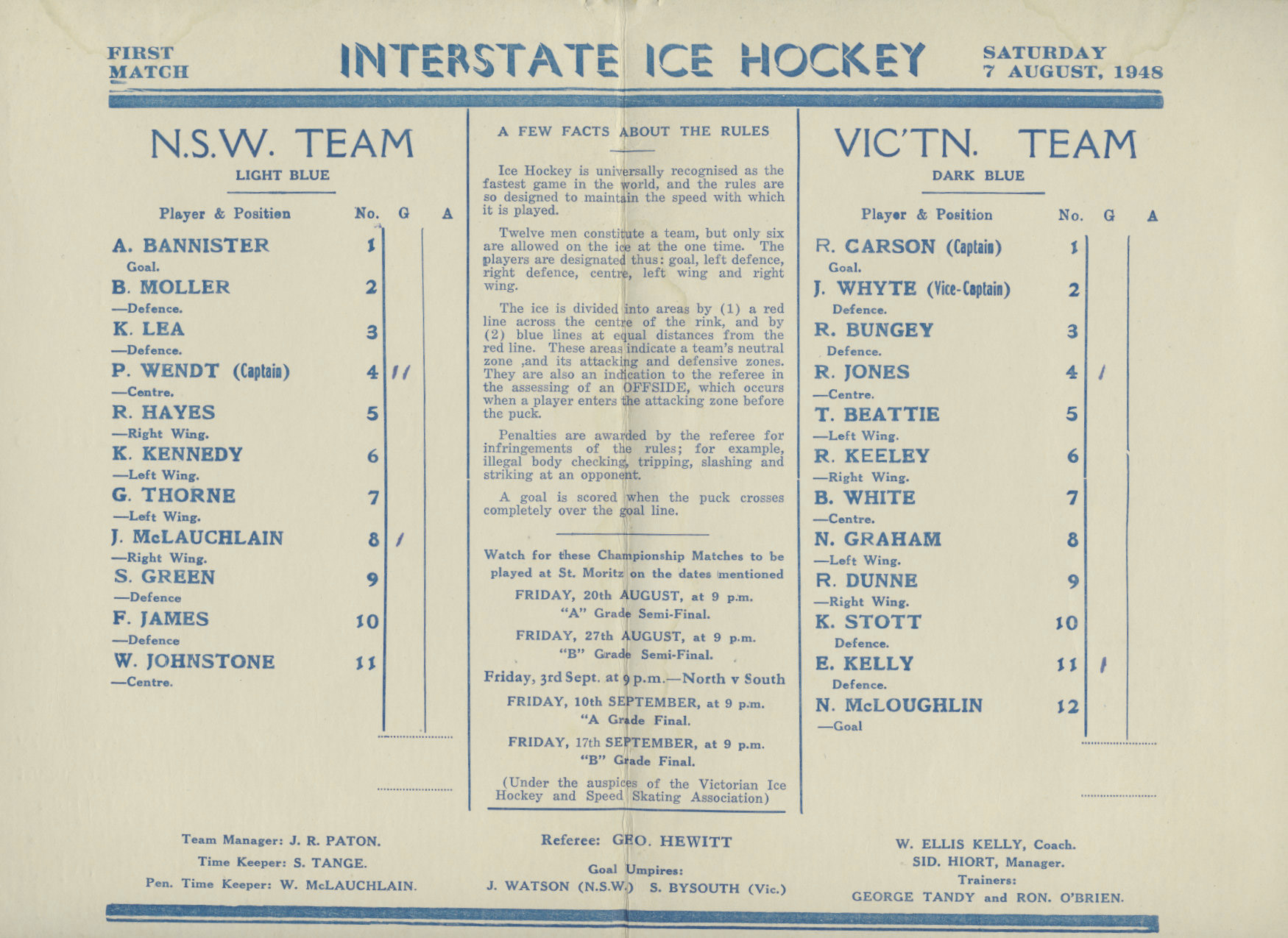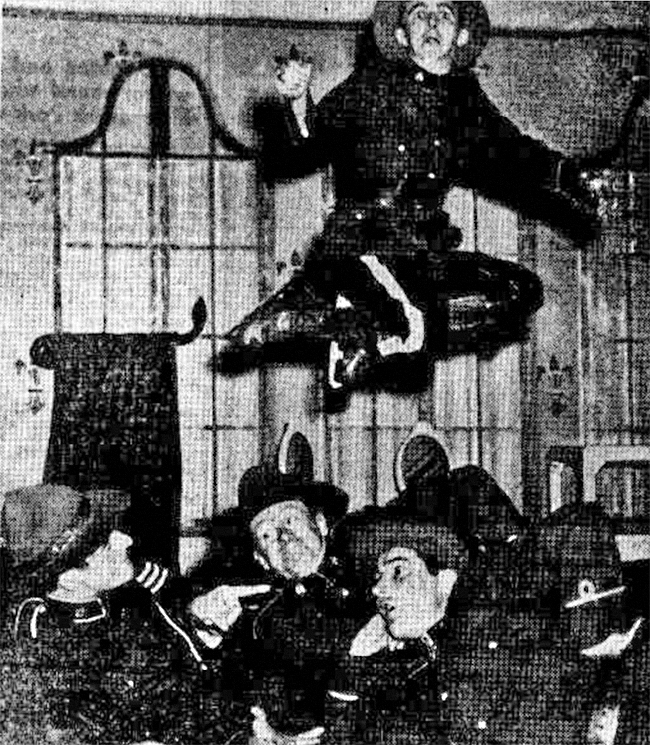

[Top] Geoff Thorne receiving Life Membership from state president Tim McMahon, Wilson Cup (preseason), Sydney Ice Arena, Sydney, 2009. Photo by Mark Bradford.
[Beneath] With Western Suburbs (right) and Bluey Mayes of the Eastern Suburbs, Sydney, September 1949. The Sun, 11 Sep, 1949.
CAREER SUMMARY
Birth
abt 1929
Sydney NSW Australia
Clubs
NSWIHA St George, Western Suburbs, Eastern Suburbs, Monarchs
Goodall Cups
1946 tie, 1948, 1950
Life Memberships
IHA (2008)
Top speed skater and ice show performer
BORN ABOUT 1929 IN SYDNEY AUSTRALIA, he was one of those homegrown players who learned ice hockey from the Canadians imported by Jimmy Bendrodt's ill-fated scheme to promote the game here just before the war. He played his first season with the St George club at 16 in 1940, probably the smallest to play in an ice hockey match in Sydney, but he made up for that with ability. At just 9 stone, he could not knock his opponents over, but "he can skate around them, make the puck do queer things on the ice, and show a sense of anticipation which is amazing for one so youthful". Two years earlier, he was unknown.
A wisp of a lad, he became friendly with Spike Roberston, one of the Kenora Thistles brought out with the Canadian Bears by Bendrodt. Thorne worked in an aircraft factory, but spent every Sunday on the ice with Robertson who taught the young Australian every trick of the game, until eventually he became a second Spike. He had the same red hair, the same control of the puck as the brilliant Canadian, and he skated in the same style, swinging on one leg with the same body sway. "All I know is due to Spike," said Thorne at the time, "He spent hours with me and I am deeply grateful for everything he showed me".
A player with Wests in the New South Wales league, he was the youngest member of the NSW State team in 1946 and later became a player and coach with the Eastern Suburbs and the Monarchs. Well-known Bondi sports masseur, Charlie Saunders, knew athletes and he considered him good enough to make any team in Canada and the United States. In 1949 he was captain of Bondi against Manly Wildcats led by Sid Green in the first ice hockey match ever played at the Manly Dungowan rink.
He won Goodall Cups in the 1946 tie, 1948 and 1950. He scored the only goal on a breakaway in his State's 1-3 defeat in that memorable 1947 game in which Victoria won back the Cup after 25 years in the wilderness. Well-known Melbourne sports commentator and journalist, Ron Casey MBE, selected him at second line centre for the 1948 All-Australian team, the first of its kind for ice hockey published by Sports Novels magazine. "Thorne's usual position is left wing, but with his height and marvellous poke check why couldn't he be made into the ideal craftsman — the necessity for a centre man? Thorne has been chosen over Ray Sullivan of Victoria because of his judgement in front of net and because of a better backhand drive". The leading goal scorer of the NSW league in 1950, he played the 2-match series against the HMCS Ontario Team in April 1951 and also represented Australia later that year against a team of "New Australians", winning 3-1.
"Mr Geoff Thorne," recalls ice racing champion and hockey player, Jim Lynch. "Too much to say about him, would fill a book. He did my skates when I started. I would stand there and watch him sharpen skates and talk about lots of things. This is about 1969. Never saw him skate, but boy I wish started skating earlier. From what I was told, they were the fun days. I skated at Bondi Junction with Jimmy Brown. He was a fantastic skater and barrel jumper. Geoff was in a great erra the best friend one could have". Former ice hockey vice-captain of Australia, Allan Harvey, said "Geoff also sharpened my skates better than anyone then, and even today. He did them vertically by hand (no machine jig) and there was never a burn mark on your blade. They literally shined. Geoff excelled at this craft — he would record the radius of your skates (scratched on a sheet of aluminium) so your skates, after each sharpening, always remained constant and balanced to your own skating style".
He was among the country's top speed skaters during the era his State produced the British champion and Australia's first Winter Olympian. He was the quarter- and half-mile NSW champion on-and-off from 1946, and one of several ice hockey players who made a name for themselves on stage when touring international ice shows were popular during the early-1950s. In Hot Ice he did a slapstick routine with Jimmie Elder (Fife Flyers), Jacques Cartaux and Fred Taylor touring Brisbane, Adelaide and Sydney in 1953, and with state ice hockey players Jim Lawrence and Graham Argue of Victoria on the Melbourne leg in 1954. A month later he led a skating comedy routine in Rose Marie On Ice in Adelaide and Melbourne, and Spice on Ice at the Tivoli in Sydney in 1956. He has been a Life Member of the national association since 2008 and he was still to be found sharpening skates in a Sydney rink in 2016.
[1] In 1940, the year Thorne first played competition hockey, the British prison ship Dunera docked carrying Germans, Austrians and Italians fleeing Hitler. There was no Goodall Cup hockey but the first grade hockey competition began May 28th at the Ice Palais on Tuesdays and the Glaciarium on Thursdays. All clubs reported increased membership and the state association was busy lifting its 3-year bans on players Widdy Johnson and Percy Wendt for their part in departing the NSW association the previous year to form their own with Jimmy Bendrodt. Wendt was overseas with the AIF.
[2] 1940 St George photo (see image gallery below) In a league that included North Sydney captained by Jim Wiseman, Glebe Panthers, Western Suburbs, Eastern Suburbs and Monarchs, St George, the last year's undefeated premiers, did it again. Captained by Jim McLauchlain, his father, Bill, filled the spot of club trainer. St George's usual captain, Jim Brown, is absent from the photo. He served in the RAAF, but sought leave to play for Glaciarium in inter-rink matches to raise war funds.
Ross Carpenter, 'Thorne, Geoff (abt 1929 - )', Legends of Australian Ice, Melbourne, Australia, http://icelegendsaustralia.com/bio_thorne.html, accessed online .
All-Australian Ice Hockey Team Chosen by Ron Casey, Sports Novels magazine, July 1948.
They're Tougher Than You Think, by Stan Gray, Sporting Globe, Melbourne 31 July 1954, p 9.
Thorne is quoted from Young Ice Hockey Player Burns-up Ice, The Sun, Sydney, June 21st 1940.





